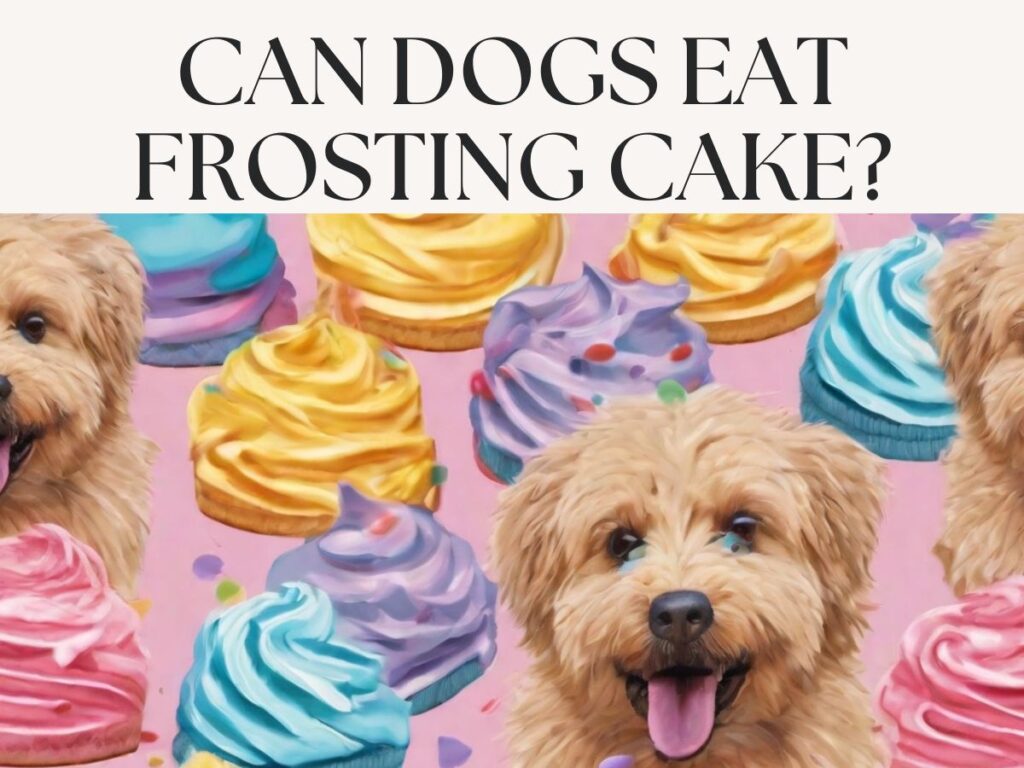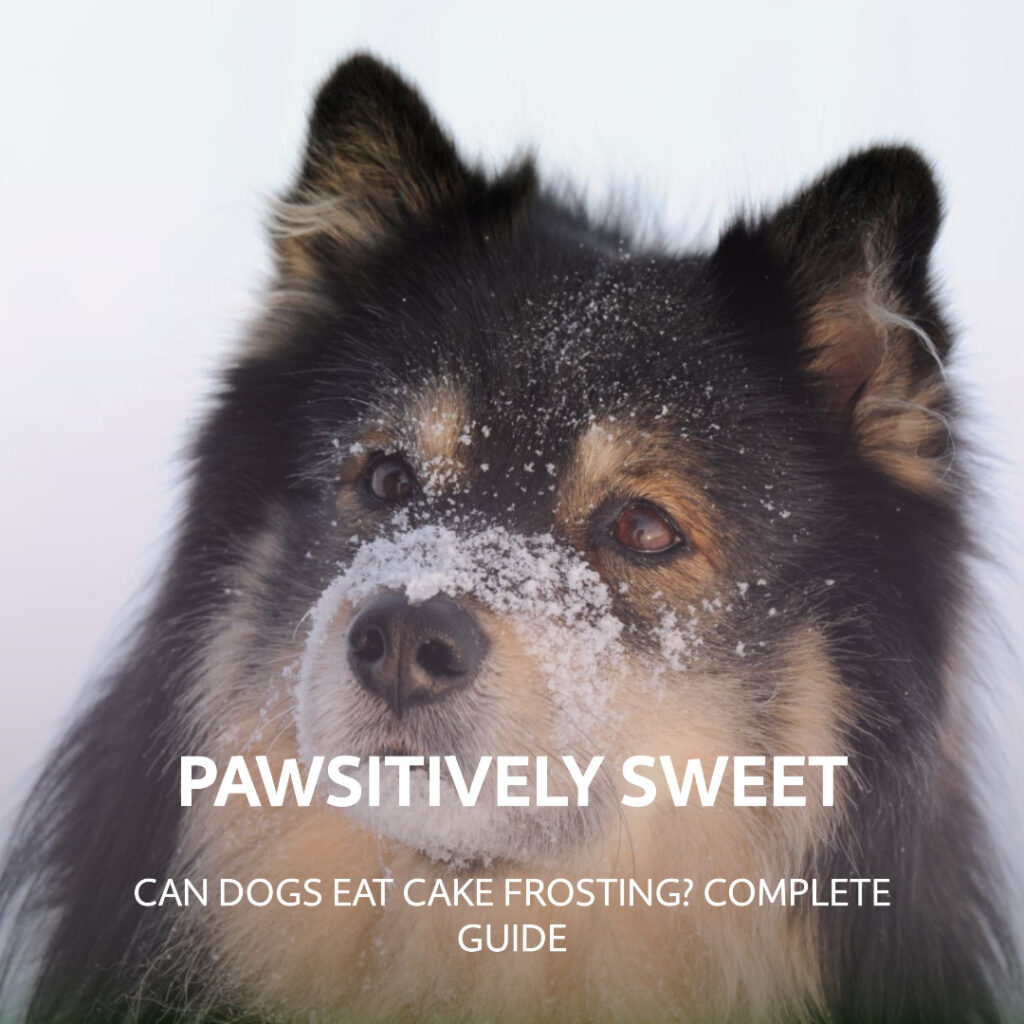Can Dogs Eat Cake Frosting?
Whether dogs can eat cake frosting depends on the type of frosting and how much is consumed. In moderation, some frostings may be relatively harmless for dogs in small licks or taste tests.

Table of Contents
Introduction: Understanding Frosting for Dogs
Dogs often exhibit an insatiable curiosity, especially when it comes to food. Frosting, with its sweet creaminess, instantly captures their attention, just as it does ours. The intense flavors and intriguing textures pique their interest and awaken their taste buds, driving their innate instinct to explore using their mouth. However, while frosting may be a delicious treat for humans, its high sugar content provides empty calories with no nutritional value for dogs. Ingesting too much can lead to obesity or even diabetes over time if consumed regularly. It’s also easy for dogs to eat too quickly, risking bloat or even choking if it’s not fully chewed. Understanding these implications becomes imperative for responsible pet owners to ensure their furry companion’s well-being and long-term health. By recognizing what foods may entice dogs but prove harmful if indulged in excess, we can properly curb their curiosity to keep them safe and satisfied.
Types of Frosting
Frosting encompasses a myriad of varieties, each bearing its unique ingredients and potential effects on dogs. Buttercream frosting, made primarily from butter, powdered sugar, and flavorings, is pleasantly sweet but also moderately rich. The high butterfat content could potentially cause an upset stomach if a dog consumes more than a small taste. Cream cheese frosting relies on cream cheese, butter or margarine, powdered sugar, and vanilla for its texture and flavor. While cream cheese provides some protein, the fat and sugar still outweigh any nutritional benefits for canines. Then there are frostings made with various confections like marshmallow creme or chocolate. These could be especially enticing to dogs but pose definite health risks due to added sugar, artificial colors or flavors, and in the case of chocolate, theobromine toxicity. Given the diverse options, from simple to indulgent varieties, it becomes important to delve deeper into the specific ingredients of any frosting and understand their differing implications for dogs. This knowledge equips guardians to make informed choices for their pet’s well-being.
- Buttercream frosting – Made with butter, powdered sugar, and flavorings like vanilla. It is rich and creamy but the butter fat can upset a dog’s stomach if eaten in large quantities.
- Cream cheese frosting – Uses cream cheese, butter or margarine, powdered sugar, and vanilla. The cream cheese provides some protein but it is still high in fat and sugar.
- Ganache – A chocolate frosting made from chocolate and cream. Not suitable for dogs due to chocolate being toxic.
- Ermine frosting – A lighter buttercream made with milk or cream, powdered sugar, and flavoring. The milk fat could potentially cause digestion issues for dogs.
- Glaze – A thin frosting made from confectioner’s sugar and water or juice. Usually less rich but still high in sugar.
- Marshmallow frosting – Marshmallow creme is mixed with butter or shortening. Very sweet and not nutritious for dogs.
- Chocolate frosting – Made with chocolate, butter, and powdered sugar. Chocolate is toxic to dogs so this type should be avoided.

Risks Associated with Frosting
While frosting may be tempting due to its sweet flavors and lush textures intriguing to dogs’ taste buds, it isn’t always benign for canine companions to consume. Many varieties of frosting are high in sugar content, with some recipe varieties containing nearly equal parts powdered sugar and other ingredients like butter, cream cheese, or milk products. Such high sugar intake provides empty calories with no nutritional value for dogs. Excess sugar can also place undue strain on their digestive system and pancreas. Additionally, some commercial frostings contain artificial colors, flavors, and preservatives, which are formulated for human consumption but not necessarily safe for dogs. Certain ingredients like chocolate, coffee, xylitol, and raisins can even be toxic.
The risks associated with frosting intake for dogs range from mild to severe, depending on the amount consumed and the ingredients. Mild risks include gastrointestinal upset, diarrhea, or vomiting from eating large amounts that are difficult for a dog’s belly to properly digest. Over time, high sugar intake leads to greater risks like weight gain, obesity, and even diabetes. Increased fat content like butter or cream could also cause pancreatitis in serious cases. Baking ingredient additions present additional danger, as even a small amount of chocolate, caffeine, or xylitol poses health risks for dogs. With so many potential issues, from discomfort to life-threatening toxicity, responsible pet owners need to understand what frosting consumption could mean for their furry friends.
Can Dogs Safely Consume Cake Frosting?
Whether furry friends can indulge in this sweet topping comes down to a close examination of its composition. Buttercream, cream cheese, and other common frostings often pose potential problems depending on the source. Their high sugar and fat content provide empty calories but lacks the nutrients dogs require. Too much consumption over time risks health issues like pancreatitis, obesity, and diabetes for our non-human family members.
Not all varieties prove equally harmful, of course. Plain buttercream or cream cheese frosting probably won’t gravely sicken the pup if an occasional modest taste is permitted. However, hidden additives lurk within store-bought variations. Artificial dyes, preservatives, and rarely even toxic substances like xylitol endanger canine wellness. Safer homemade creations still concentrate sugar and fat, demanding judicious moderation by informed guardians.
Moreover, individual tolerance levels vary among people. While small doses may not damage most adult dogs, puppies or those with pre-existing conditions require extra caution. Size must also factor in – tiny licks suit Great Danes far less than teacup companions. Overall, informed pet parents understand this indulgence stays reserved for human enjoyment. Offering balanced diet staples instead keeps furry friends fit and safe for shared happiness.
Responsible owners carefully consider all risks before permitting any frosting tastes. Safety proves the highest priority over momentary pleasure when stewarding beloved non-human families. Knowledge empowers making choices in the canine’s best interests for healthful lives together.

Can Dogs Eat Cake Frosting With Buttercream?
Buttercream frosting, with its silky texture and pleasant sweet creaminess, is arguably one of the most beloved frosting varieties gracing many celebratory cakes. Humans are easily captivated by its allure, which also charms the palates of our canine companions. However, while it may seem a delightful treat on the surface, butter cream’s rich composition requires careful consideration of potential health repercussions for our dogs.
Made primarily from butter, confectioners’ sugar, and flavorings like vanilla or almond extract, buttercream boasts a high fat and sugar content with little nutritional value for canines. Butter provides many healthy fats when consumed moderately by humans, but dogs have shorter digestive tracts less capable of fully processing high fat intake. Too much buttercream risks giving a dog’s pancreas unwanted strain. Moreover, the copious amounts of sugar spike blood glucose levels without balancing fiber or protein. Over time, frequent small indulgences or occasional over indulgences alike could enable health issues like pancreatitis, obesity, and even diabetes in our furry friends.
Understanding these considerations, responsible owners minimize offering buttercream as anything more than rare small-taste treats for curious pups. A few thoughtful licks likely won’t damage an adult dog’s wellness, but anything beyond that requires acknowledging the possible repercussions for a canine’s personal health parameters. Making in
Can Dogs Eat Cake Frosting: Cream Cheese?
Cream cheese frosting presents an enticing alternative to traditional buttercream, adding an appealing creaminess balanced by a subtle tang. For humans, its light and lush qualities make it a festive favorite filling or coating for cakes, cupcakes, and more sweet treats. However, just because it tastes splendid to our palates does not necessarily mean a dog’s gut will find it agreeable.
Made with cream cheese, butter or margarine, powdered sugar, and vanilla as the prime players, this variety certainly boasts creaminess but also carries a high fat and sugar payload. While cream cheese provides some protein benefits for people, its dairy components could potentially upset a dog’s digestive balance, especially in overindulgent portions. Their systems are adapted to mostly meat-based diets and are less equipped to fully process large amounts of saturated fat from cheese and butter alike.
Furthermore, frequent treats of cream cheese frosting’s 50% fat, 25% protein, and 25% carbohydrate profile disproportionately favor fats and carbs over proteins, creating insufficient nourishment compared to their whole prey diet in nature. Prolonged intake risks issues like pancreatitis, obesity, and other health troubles stemming from this imbalance.
Careful consideration of these variables proves paramount for guardians to make the right calorie absorption calculations for each pup. Enjoyment of such toppings stays mindfully occasional and controlled for canine well-being. Their lives depend on our wise guidance for lifelong happiness together.

Cupcakes without Frosting: A Dog’s Diet
While removing frosting from the equation may initially appear a sound solution, further scrutiny reveals cupcakes still present compromises to canine wellness in their core components. Refined flours provide simple carbohydrates that are neither necessary nor beneficial in a dog’s natural diet. Sugar remains heavily featured within typical recipes, even with topping removal, demanding the same caution against regular portions.
Additional additives pose variances too depending on the products used. Chemical items like baking soda and powder often contain potassium bicarbonate and aluminum compounds, respectively – definite no-nos for our furry friends. Eggs involve moderate protein but also potential egg allergy for sensitive pups. Melted dairy components like butter or milk pose concerns akin to cream cheese frosting due to indigestible fat percentages.
Fruit purees commonly enrich flavor yet come with intense sugar loads as well. Nuts frequently complement texture; however, some varieties dangerously resemble chocolate in toxicity for dogs. Artificial colors or preservatives present in boxed mixes add unjustified risks to benefit ratios. And let’s not forget potential choking hazards from non-edible decor elements adorning commercially sold cupcakes.
Taking these complicated issues into consideration, verified all-natural, unfrosted “cupcakes” designed for species-appropriate hydration and nutrition seem far safer rare treats than humanized fare. Guardians must weigh all factors comprehensively for four-legged family health priorities above temporary temptations. Their well-being depends on our prudent decisions.
Can Dogs Eat Cake Frosting With Vanilla?
At an initial glance, the simplicity of a vanilla sponge cake adorned with a smooth swath of frosting seems like a harmless candidate for sharing flavorful tastes with awaiting tongues. However, conscientious inspection proves paramount before permitting primordial tummy tenants any such novel nourishment. Dissecting each part isolates understanding their probable performance traversing a hound’s innards.
The fluffy cake foundation looks lovely, but one must scrutinize its structure. Refined wheat and corn flour deliver sugary carbohydrates foreign to native diets. Chemical elevators like baking soda pose potential gastric grievances. Creams and oils add indulgent, albeit indigestible, fats. Summing each ingredient unveils an innutritious imbalance for Fido.
Meanwhile, among frostings, the light lotion loaf’s lard or margarine, sugars, and tang hint tolerable in moderation. However, the risk of volume consumed must consider its inevitable impact. Frequent treats may unsettle, as high-calorie meals tax tender tummies and stouter silhouettes emerge.
Ultimately, duties as devoted doggie defenders demand discerning what dietary selections suit simpatico systems. Dividing consumed comestibles into constitutive components illuminates nuanced nutrition knowledge nurturing health always. With prudence, periodic delight shares palate pleasures pleasingly.
Examining Vanilla Frosting for Dogs
At first glance, vanilla frosting may seem a relatively benign option for sharing sweet satisfaction with waiting tongues, but its mild flavor profile is perceived as practically puritanical compared to richer varieties. However, conscientious examination proves imperative when considering canine compatibilities. Beyond superficial simplicities lurk sugars and substances warranting scrutiny.
Upon closer inspection, most recipes lay the foundation with a base of butter, shortening or margarine blended meticulously with monumental mounds of powdered sucrose. To this, flavor agents like vanilla bean or extract are added, amplifying overall appeal yet potentially posing problems particular to pups. While fragrant to human hounds, such formulas translate nutritionally to concentrated carbohydrates lacking complementary protein, fiber, and other fundamentals fit for the four-legged.
This presents a particular pause regarding potential portion size and prolonged intake. High-calorie counts from such frequent frivolities could culminate troublesomely over time, taxing delicate digestive domains and straining sensitive systems. Furthermore, excessive or consistent sugar surge raises risks for pancreatitis, obesity, metabolic irregularities, and related long-term health issues endemic to our furry friends. Even infinitesimal flavoring fractions pose a rare possibility allergenic reaction in particular pups.
Do such perils necessarily proscribe periodic partaking altogether? Not definitively – judicious tastes in miniature morsels likely bring no immediate effects untoward. Regardless, enlightened individuals understand moderation alone fails to mitigate all multifarious factors in play. Comprehensive consideration of constituent components, caloric cargo, and canine constitution remains requisite for any nuanced decisions made in their best interests.
Frosting Suitable for Dogs
When it comes to special occasions or homemade treats, many dog owners may wonder if there are frosting options that are safe and suitable for their furry companions. While traditional frosting recipes often contain ingredients that can be harmful to dogs, there are alternative options that can be used to create dog-friendly frostings. These frostings are typically made with ingredients that are safe and healthy for dogs, allowing you to add a touch of sweetness to their treats without compromising their well-being.
One popular and dog-friendly option for frosting is yogurt-based frosting. Plain, unsweetened yogurt can be a great base for creating a creamy and delicious topping. Simply choose a yogurt that does not contain any added sugars, artificial sweeteners, or xylitol, as these can be toxic to dogs. You can then mix the yogurt with a small amount of natural, dog-safe sweeteners such as honey or mashed banana for added flavor. This yogurt-based frosting is not only safe for dogs, but it also provides some nutritional benefits, as yogurt is a good source of calcium and probiotics.
Another option for dog-friendly frosting is peanut butter frosting. Dogs often have a fondness for the taste of peanut butter, and it can be used to create a simple and tasty frosting. Opt for natural peanut butter that does not contain added sugars, salt, or xylitol. To make the frosting, you can combine peanut butter with a small amount of yogurt or mashed banana to achieve a smooth and spreadable consistency. This peanut butter frosting can be a delightful addition to homemade dog treats or even used as a filling for dog-friendly cakes.
It’s important to note that while these homemade frostings are safe for dogs in moderation, they should still be given as occasional treats and not as a staple in their diet. Too much sugar, even in dog-friendly forms, can have negative impacts on a dog’s health. Additionally, it’s always a good idea to consult with your veterinarian before introducing any new ingredients into your dog’s diet, especially if they have specific dietary restrictions or health concerns.
By opting for dog-friendly frostings, you can add a touch of sweetness to your dog’s special treats while keeping their health and well-being in mind. Whether you choose yogurt-based or peanut butter-based frostings, remember to use them in moderation and alongside a balanced and nutritious diet. Your furry friend will surely appreciate the extra love and effort you put into making their treats extra special.
FAQs about Dogs and Frosting
Addressing common queries about dogs and frosting aids in dispelling myths, providing clarity, and offering guidance to pet owners navigating these culinary conundrums.
Q: Can dogs eat cake frosting made for humans?
A: No, regular frosting made for humans is not recommended for dogs. It often contains ingredients like sugar, artificial sweeteners, chocolate, or xylitol, which can be harmful or toxic to dogs. It’s best to avoid giving your dog frosting meant for human consumption.
Q: Is yogurt-based frosting safe for dogs?
A: Yes, yogurt-based frosting can be a safe option for dogs. Plain, unsweetened yogurt without any added sugars or artificial sweeteners can be used to create a dog-friendly frosting. However, it should still be given in moderation and as an occasional treat.
Q: Can Dogs Eat Cake Frosting with xylitol?
A: No, dogs should never consume frosting or any other products that contain xylitol. Xylitol is highly toxic to dogs and can cause a rapid drop in blood sugar levels, leading to potential liver damage and other serious health issues. Always check ingredient labels and avoid any products with xylitol when feeding your dog.
Q: What are some dog-safe sweeteners I can use in frosting?
A: When making frosting for dogs, you can use natural, dog-safe sweeteners such as small amounts of honey, mashed banana, or unsweetened applesauce. These options can add a touch of sweetness without posing significant health risks to dogs.
Q: Can frosting be harmful to dogs?
A: Frosting, especially those made for human consumption, can be harmful to dogs due to their high sugar content and potentially toxic ingredients. It is important to choose dog-friendly frosting options made with safe ingredients and to provide it to your dog in moderation as an occasional treat.
Q: Should I consult with a veterinarian before giving my dog frosting?
A: It is always a good idea to consult with a veterinarian before introducing any new ingredients or treats into your dog’s diet. They can provide personalized advice based on your dog’s specific needs, dietary restrictions, and health conditions, ensuring their safety and well-being.
By addressing these common questions, pet owners can make informed decisions when it comes to feeding their dogs frosting. Remember to prioritize your dog’s health and consult with a veterinarian if you have any concerns or specific dietary considerations for your furry friend.
Related:
Conclusion
Can Dogs Eat Cake Frosting? Exploring the realm of frosting within a dog’s diet requires careful consideration and well-informed choices. While certain types of frosting may pose potential risks, there are safe options that can be thoughtfully incorporated into their occasional treats. It is crucial to have a comprehensive understanding of ingredients, practice moderation, and be aware of each dog’s individual tolerance levels to ensure that they can enjoy these indulgences without compromising their well-being. Above all, prioritizing the health and safety of our furry companions should always be the guiding principle as we navigate the delightful world of frosting. By approaching it with a discerning eye and making informed decisions, we can create a balance between treating our dogs and ensuring their overall well-being.


Pros and Cons of Retired Breeding Dogs: A Comprehensive Guide - Pawsgal
[…] Check out: Can Dogs Eat Cake Frosting? […]